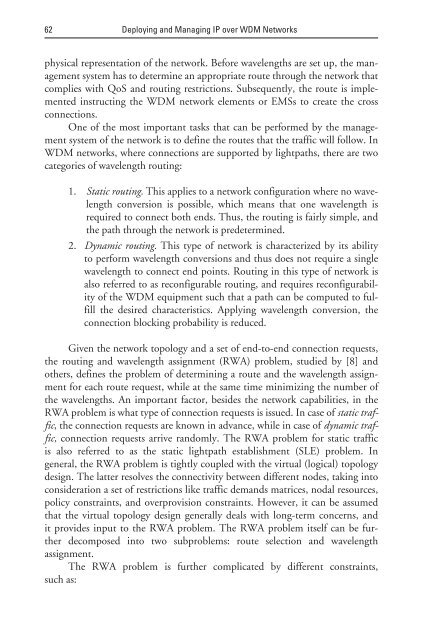deploying and managing ip over wdm networks - Index of
deploying and managing ip over wdm networks - Index of
deploying and managing ip over wdm networks - Index of
Create successful ePaper yourself
Turn your PDF publications into a flip-book with our unique Google optimized e-Paper software.
62 Deploying <strong>and</strong> Managing IP <strong>over</strong> WDM Networks<br />
physical representation <strong>of</strong> the network. Before wavelengths are set up, the management<br />
system has to determine an appropriate route through the network that<br />
complies with QoS <strong>and</strong> routing restrictions. Subsequently, the route is implemented<br />
instructing the WDM network elements or EMSs to create the cross<br />
connections.<br />
One <strong>of</strong> the most important tasks that can be performed by the management<br />
system <strong>of</strong> the network is to define the routes that the traffic will follow. In<br />
WDM <strong>networks</strong>, where connections are supported by lightpaths, there are two<br />
categories <strong>of</strong> wavelength routing:<br />
1. Static routing. This applies to a network configuration where no wavelength<br />
conversion is possible, which means that one wavelength is<br />
required to connect both ends. Thus, the routing is fairly simple, <strong>and</strong><br />
the path through the network is predetermined.<br />
2. Dynamic routing. This type <strong>of</strong> network is characterized by its ability<br />
to perform wavelength conversions <strong>and</strong> thus does not require a single<br />
wavelength to connect end points. Routing in this type <strong>of</strong> network is<br />
also referred to as reconfigurable routing, <strong>and</strong> requires reconfigurability<br />
<strong>of</strong> the WDM equ<strong>ip</strong>ment such that a path can be computed to fulfill<br />
the desired characteristics. Applying wavelength conversion, the<br />
connection blocking probability is reduced.<br />
Given the network topology <strong>and</strong> a set <strong>of</strong> end-to-end connection requests,<br />
the routing <strong>and</strong> wavelength assignment (RWA) problem, studied by [8] <strong>and</strong><br />
others, defines the problem <strong>of</strong> determining a route <strong>and</strong> the wavelength assignment<br />
for each route request, while at the same time minimizing the number <strong>of</strong><br />
the wavelengths. An important factor, besides the network capabilities, in the<br />
RWA problem is what type <strong>of</strong> connection requests is issued. In case <strong>of</strong> static traffic,<br />
the connection requests are known in advance, while in case <strong>of</strong> dynamic traffic,<br />
connection requests arrive r<strong>and</strong>omly. The RWA problem for static traffic<br />
is also referred to as the static lightpath establishment (SLE) problem. In<br />
general, the RWA problem is tightly coupled with the virtual (logical) topology<br />
design. The latter resolves the connectivity between different nodes, taking into<br />
consideration a set <strong>of</strong> restrictions like traffic dem<strong>and</strong>s matrices, nodal resources,<br />
policy constraints, <strong>and</strong> <strong>over</strong>provision constraints. However, it can be assumed<br />
that the virtual topology design generally deals with long-term concerns, <strong>and</strong><br />
it provides input to the RWA problem. The RWA problem itself can be further<br />
decomposed into two subproblems: route selection <strong>and</strong> wavelength<br />
assignment.<br />
The RWA problem is further complicated by different constraints,<br />
such as:


